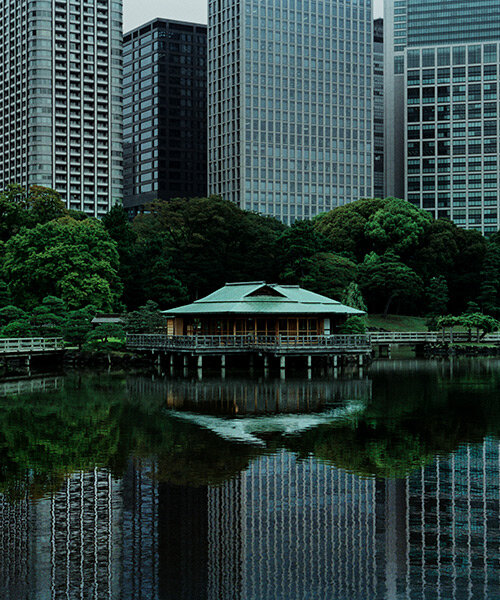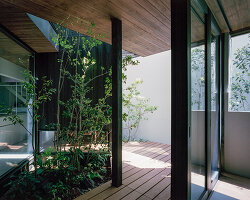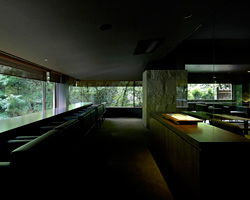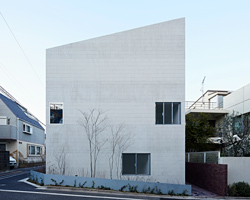Architect Makoto Yamaguchi & photographer Kentaro Kumon capture japanese majesty
Architect Makoto Yamaguchi sets out on a journey with photographer Kentaro Kumon to discover the shakkei, or ‘borrowed scenery’, of Japanese landscape. While visiting famous gardens all over the country, the two contemplate aspects of the local culture through the fascinating scenery. As the camera captures the connection between the modern and the traditional, a new discovery begins to appear: different materials co-existing side by side.
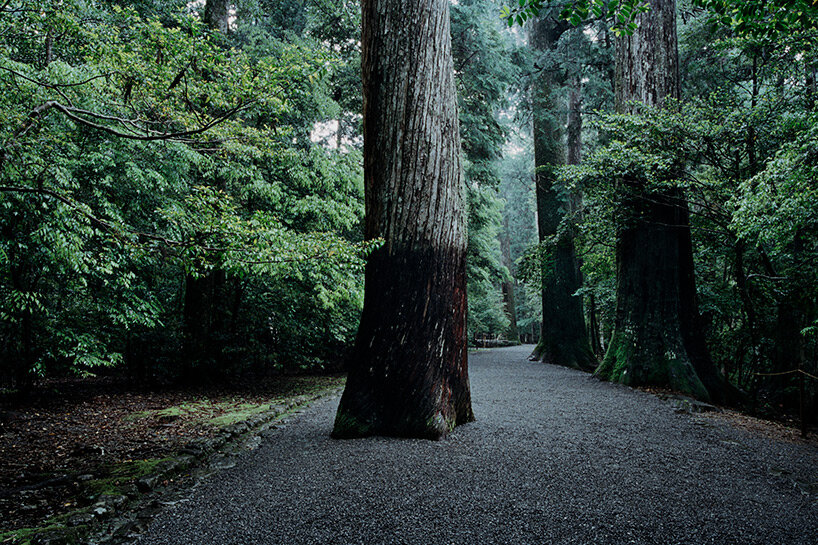
(above) Betsugu of the Ise Inner Shrine, Takihara-no-Miya Shrine #2 / Mie: a large tree grows on the path leading to the shrine, obstructing the approach. Although the tree’s existence is counter to the purpose of the pathway, it is not completely blocking but appears to exist independent of it. In this relationship of irrelevance is a truly beautiful landscape.
(banner) Hama-rikyu Gardens / Tokyo: the skyscrapers that stand adjacent, yet unrelated, to the Japanese architecture masterpiece resemble an inorganic forest. Thus they have become a new shakkei for the Hama-rikyu Gardens.
makoto and kentaro travel the country to discover shakkei
Architect and garden researcher Makoto Yamaguchi seeks to discover the hidden magic of Japanese culture and, together with photographer Kentaro Kumon, a new adventure begins. Their travels reveal shakkei – the borrowed scenery of the Japanese countries. As the lens captures the fascinating greenery, ‘neighboring textures’ start to appear, giving a deeper insight into different materials existing side by side.

Entsu-ji Temple / Kyoto: a masterpiece of a shakkei garden, uses Mount Hiei as its borrowed scenery. However, there is not necessarily a strong relationship between the garden and the distant scenery. The two materials are quietly adjacent to each other.
The camera lens travels all over the country revealing that there is no real divide between modernity and tradition – the two are rather closely related. Some Japanese gardens are considered ‘shakkei (borrowed scenery) gardens,’ where one of the best examples is the Entsu-ji Temple built in 1678. The project features a ‘borrowed’ view of Mount Hiei, an extremely important element of Kyoto culture. However, as the mountain is far away, the value of the architecture becomes hazy. The principle behind the captivating beauty in such gardens is what Makoto Yamaguchi refers to as ‘neighbouring materials,’ where diverse materials meet. This in turn provides clues to understand Japanese culture, as the connection between tradition and modernity merge.

Higashiyama Jisho-ji Temple #1 / Kyoto: although the shakkei by definition must exist outside the garden, Kogetsudai as an artificial and abstract mountain is a shakkei that exists within the garden. Here, Kogetsudai as a borrowed landscape can be seen from various spots, which is quite intriguing.
‘There may soon come a day when the pandemic settles down, and you become interested in traveling to East Asia. You might consider China, Korea, and Japan as your destination. You will be able to find information on each country, and they all will look very appealing. If you look closely, you may find that China and Korea look very bright-colored and vibrant, while Japan may seem a bit plain. Nevertheless, if you are still interested in Japan, it may be due to manga, Akihabara, or kawaii culture. Or you might be drawn to traditional cultures, such as kimono and sushi, which may seem unrelated to such contemporary cultures. There is a great divide between the modern and the traditional, and yet the mixing of these aspects can be seen everywhere. Experiencing this chaos is a major attraction of a visit to Japan,’ says Makoto Yamaguchi.

Shugakuin Imperial Villa #1 / Kyoto: two things of different natures stand next to each other: a pine tree carefully groomed for viewing, and a paddy field that exists for practicality. all images courtesy of Makoto Yamaguchi
the photographs can be witnessed in person until july 30, 2022
The architect and photographer have been traveling together for almost two years. First, Makoto Yamaguchi travels alone in search of the long history gardens of up to 1,500 or older. When found, the pair travels back together to the same place, where they continue to make discoveries through a cycle of photoshoots and discussions. The project in progress can be viewed in person at MYD Gallery in Tokyo, until July 30, 2022.

Katsura Imperial Villa / Kyoto: the fence at Katsura Imperial Villa is made of bent bamboo, but right behind it is the same species of bamboo growing straight up. Thus the different compositions of bamboo exist next to each other to create a hedge.

Kokyo Gaien National Garden / Tokyo: the stone wall from Edo Castle and the newly-laid clean-shaped paving stones from the district redevelopment around Tokyo Station exist adjacently. Both are stone materials, but the wall is made of large irregular-shaped black stones. In contrast, the paving is made of small rectangular white Inada granite.

Koishikawa Korakuen Gardens / Tokyo: the abstract white exterior of Tokyo Dome and its incomparably huge scale, when captured as a shakkei from Koishikawa Korakuen Garden, becomes a piece of nature in itself, like a mountain.

Ritsurin Garden / Kagawa: the view of the Nan-ko pond from Kikugetsu-tei is truly fascinating. The pond evokes an image of Shangri-La, while the porch of Kikugetsu-tei faces the water surface. The two components are adjacent to each other quite unexpectedly but without any sense of boundary, acquiring a sense of unity.

Shugakuin Imperial Villa #3 / Kyoto: in Jugetsukan Pavilion, the rain gutter made of bamboo stretches into the air, extending the architectural elements independently. Looking up, the gutter holds out into the empty sky, becoming a shakkei and creating a landscape that draws the eye.
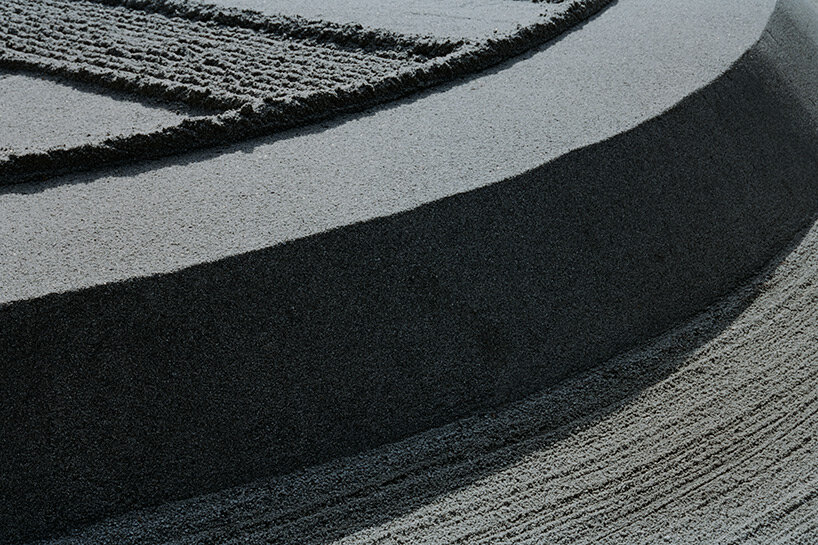
Higashiyama Jisho-ji Temple #2 / Kyoto: it portrays the famous Ginshadan. The same white sand is used to create different textures from smooth to thick-grooved, fine-grooved, and ribbed surfaces.

Shugakuin Imperial Villa #2 / Kyoto: the paving stones of Rakushiken in the Middle Imperial Palace are in harmony by arranging stones of different textures and colors. Two types of stones both in dark gray but with slightly different textures, a sandy white patch of stones sandwiched between them, and a patch with a mixture of white and dark gray stones are placed next to each other.






project info:
name: Shakkei – Neighbouring Materials
architect: Makoto Yamaguchi
photography: Kentaro Kumon
exhibition: MYD Gallery in Tokyo – Japan, until July 30, 2022
